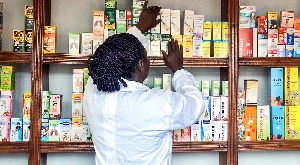 Pharmacists have been instructed to refer all H1N1 cases to the nearest health post
Pharmacists have been instructed to refer all H1N1 cases to the nearest health post
Pharmacists in Ghana have been advised never to sell drugs to persons showing symptoms of H1N1 Influenza and Cerebral Spinal Meningitis (CMS).
The Pharmaceutical Society of Ghana (PSGH) has warned its members to be on the high alert following the outbreak of the two diseases, especially in the middle and northern belts of Ghana. Pharmacists have therefore been instructed to refer such cases to the nearest health post since prevention of “these diseases is by vaccination.”
“The moment you identify the symptoms above in a client who visits your premises, please refer to the nearest health facility that can manage the case. Early referral is necessary for survival and please do not attempt to provide a first aid since that could mask the diagnosis and possible good prognosis. Prevention of these diseases is by vaccination when travelling to an endemic area and observing infection prevention and control (IPC) measures,” the president of PSGH Benjamin Botwe said in a circular to pharmacists.
He added: “All pharmacists are encouraged to support the national effort by observing and documenting the evidence of suspected cases to disease control offices in their catchment areas.”
Below is the full statement
13th December, 2017
CIRCULAR TO PHARMACISTS ON H1N1 INFLUENZA AND CSM IN GHANA
The leadership of the Pharmaceutical Society of Ghana (PSGH) has noted with much concern the recent outbreak of H1N1 Influenza (Influenza A Virus sub-type H1N1) in Kumasi Academy Senior High School (KUMACA) that has claimed the lives of some students.
The leadership of the PSGH is also deeply concerned about the reports of bacterial meningitis in Koforidua Secondary Technical School.
The Society has also noted how the Ministry of Health and other stakeholders have moved with swiftness to contain the spread of the infections through appropriate preventive and treatment initiatives.
PSGH wishes to bring to the attention of its members especially Pharmacists in Community Practice to be on the look-out for flu-like signs and symptoms and help in early detection by prompt referral of any suspected H1N1 infection,
H1N1 Influenza Transmission
H1N1 Influenza also known as swine flu is a highly contagious respiratory disease in pigs caused by one of several swine influenza A viruses. The H1N1 virus can be transmitted to humans via contact with infected pigs or environments contaminated with the virus.
Similar to common seasonal flu strains, the swine influenza A (H1N1) virus is spread from person-to-person by airborne droplets expelled from the respiratory tract during talking, coughing or sneezing.
H1N1 Influenza Signs and symptoms
Manifestations of H1N1 influenza are similar to those of seasonal influenza. Patients present with symptoms of acute respiratory illness, including at least 2 of the following:
• Fever
• Cough
• Sore throat
• Body aches
• Headache
• Chills and fatigue
• Diarrhoea and vomiting (possible)
In children, signs of severe disease include apnoea, tachypnoea, dyspnoea, cyanosis, dehydration, altered mental status, and extreme irritability.
In addition to H1N1 Influenza, we also urge members to look out for Cerebrospinal Meningitis (CSM) as we approach the harmattan season.
CSM Transmission
The bacteria is transmitted from person-to-person through droplets of respiratory or throat secretions from carriers. Close contact – such as kissing, sneezing or coughing, or living in close quarters (such as a dormitory, sharing eating or drinking utensils) with affected individuals (a carrier) – facilitates the spread of the infection. The average incubation period is 4 days, but can range between 2 and 10 days depending on the immune status of the infected individual.
CSM Signs and Symptoms
The classic triad of bacterial meningitis consists of the following:
• Fever
• Headache
• Neck stiffness
Other symptoms are; high fever (38 degrees C and above), sensitivity to light, confusion, headaches and vomiting. Even when the disease is diagnosed early and adequate treatment is started, 5% to 10% of patients may die, typically within 24 to 48 hours after the onset of symptoms, hence the need for prompt referral of all suspected cases. Bacterial meningitis may result in brain damage, hearing loss or a learning disability in 10% to 20% of survivors. A less common but even more severe (often fatal) form of meningococcal disease is meningococcal septicaemia, which is characterized by haemorrhagic rash and rapid circulatory collapse.
What Community Pharmacists should do
1. The moment you identify the symptoms above in a client who visits your premises, please refer to the nearest health facility that can manage the case. Early referral is necessary for survival and please do not attempt to provide a first aid since that could mask the diagnosis and possible good prognosis. Prevention of these diseases is by vaccination when travelling to an endemic area and observing infection prevention and control (IPC) measures.
2. All pharmacists are encouraged to support the national effort by observing and documenting the evidence of suspected cases to disease control offices in their catchment areas.
The history should also address the following:
• Epidemiologic factors and predisposing risks
• Exposure to a patients or animals with a similar illness
• Previous medical treatment and existing conditions
• Geographic location and travel history
• Season and temperature
The general public is advised to visit their community pharmacies and general practitioners for any ill-health as soon as possible as delays can lead to complications and irreversible damages.
Pharm. Benjamin Botwe,
President












